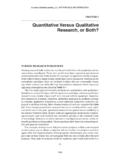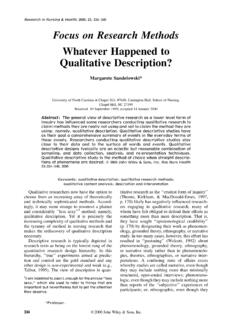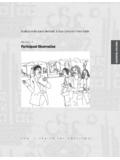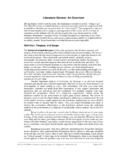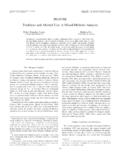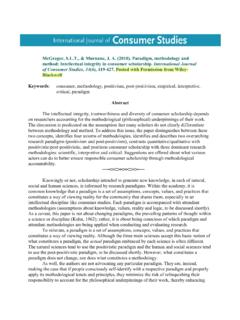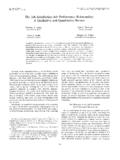Transcription of Quantitative versus Qualitative Methods: …
1 Journal of Theoretical and Philosophical Criminology, Vol 1 (1) 2009 Quantitative versus Qualitative methods : understanding Why Quantitative methods are Predominant in Criminology and Criminal JusticeGeorge E. Higgins University of LouisvilleAbstract The development of knowledge is important for criminology and criminal justice. Two predominant types of methods are available for criminologists to use-- Quantitative and Qualitative methods . A debate is presently taking place in the literature as to which of these methods is the proper method to provide knowledge in criminology and criminal justice. The present study outlines the key issues for both methods and suggests that a criminologist research questions and hypotheses should be used to determine the proper method.
2 Quantitative versus Qualitative methods : understanding the methods in CriminologyResearch is the discovery of information that is either new or replicates previous findings. Research becomes scientific when if follows specific methodologies that others may be able to replicate to arrive at similar results. Two types of methodologies are predominant in criminology and criminal justice that provide this sense of science-- Quantitative and Qualitative methods . However, Tewksbury, DeMichele, and Miller (2005) have shown that Quantitative methods are used more often than Qualitative methods in criminology and criminal justice. Importantly, Quantitative and Qualitative methods differ in several ways.
3 The present study contributes to the literature by presenting a theoretical treatment of Quantitative and Qualitative research. The study begins by presenting Quantitative and Qualitative 23 Journal of Theoretical and Philosophical Criminology, Vol 1 (1) 2009 24methods. Then, the importance of sampling to both methodologies comes. This is followed by discussions of the primary methodologies that are used in either approach. The data that are presented in each approach are presented. Then, the issues surrounding reliability of both methods are presented. This is followed by the discussion. Quantitative and Qualitative ResearchQuantitative methods are based on the premise of empiricism and positivism (Rossi, 1994; Smith, 1983).
4 These methods are rooted in the scientific method that is derived from the physical and natural sciences. Generally, these methods allow criminologists to be objective, formal, and systematic that arrives at a series of numbers to quantify phenomena (Creswell, 1994). That is, criminologists measure phenomena objectively affording them the opportunity to remain distant and be independent of the phenomena that is being researched. This is consistent with the role of values in research. Using Quantitative methods , research is able to be devoid of values. Values are removed from the research process because statements in written reports and instruments are removed (Babbie, 2002).
5 Criminologists argue the facts of the study and not the values of the study. Criminologists that use Quantitative methods write their reports in very specific ways. First, the reports are written impersonally. This allows them to keep their distance and to make sure that their values are not interwoven into their research. Second, their reports are written in a formal tone with an emphasis on the connections, comparisons, and group differences between the concepts that are being studied. For instance, Higgins (2007) presented a report that examined the psychometrics of a specific self-control scale. Importantly, this paper was written in a very formal tone that was removed of Journal of Theoretical and Philosophical Criminology, Vol 1 (1) 2009 values, but Higgins relied on the numbers to provide evidence to support or refute the hypotheses of the study.
6 The issues of concepts in Quantitative research are important. Criminologists use theory to define their concepts and the connections between them. A theory is a set of interrelated or intercorrelated concepts and propositions that are designed to explain a behavior. In criminology, the behavior is typically criminal or deviant. Agnew (1995) argued that social learning, self-control, and strain theories were the leading general crime theories in criminology and criminal justice. Quantitative methods allow criminologists to be deductive in stating their hypotheses and research questions a priori from established theory, allowing criminologists to test theories and examine relationships for cause and effects.
7 For example, Agnew (1992) argued that three forms of strain generate an emotion that prepares the individual to cope with the strain. In this example, three hypotheses are presented. The first is a direct hypothesis from the three forms of strain generating an emotion. The second is a hypothesis that emotion prepares an individual to cope. The third is implied and suggests that strain has an indirect connection with coping through emotion that may be conditioned by: criminal histories, peer association, or morality. Qualitative methods are guided by ideas, hunches, or perspectives (Creswell, 1994; Rossi, 1994). Criminologists that use Qualitative methods are usually trying to develop theories rather than test them.
8 In addition, the intention is to use the language of the subject to provide the understanding and not the quantity of the subjects. In other words, Qualitative methods are subject ( , study respondent) driven and not theory driven. This allows criminologists to describe phenomena in a more humanistic and phenomenological view. Using an interview format, the Qualitative researcher would focus on coping mechanisms and then proceed 25 Journal of Theoretical and Philosophical Criminology, Vol 1 (1) 2009 backwards as to understand why the individual coped in a certain way. This is an example of subject generated research rather than theory driven research.
9 The reason why the individual copes in this manner is induced and a theory is created for understanding . Qualitative criminologists will argue that their lack of dominance in criminology and criminal justice is due to the belief that the development of theory is secondary or invaluable. Quantitative criminologists recognize that falsifying the theories are far more important. To be clear, a theory derived from 10 to 15 research subjects needs to be examined across several thousand individuals or groups before it may be reified. This has been the case with the leading crime theories ( , social learning theory, self-control theory, and General Strain theory) (Agnew, 1995).
10 It should be noted that these theories were not developed using Qualitative methods , perhaps this is the reason why they have withstood multiple rigorous Quantitative tests that transcend disciplines, races, ethnicities, and countries. Qualitative methods allow criminologists to become part of the study by shortening the distance between him or herself and the research subject. Thus, they are typically the instrument allowing them to interject his or her values into the research (Babbie, 2002). This may occur in participant observation research where the researcher infiltrates a setting and participates in the activity so that they may gain access and acceptability among subjects.
